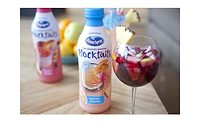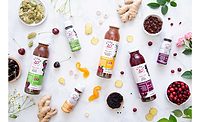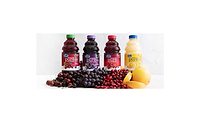Ocean Spray
By SARAH THEODORE
Still making waves after 75 years
Ocean Spray Cranberries,
Lakeville-Middleboro, Mass., has made the cranberry such an American staple
that it’s easy to forget how unique its product really is. The
cranberry is one of only three fruits (along with the blueberry and the
Concord grape) native to North America, and left to its own devices, it is
a bitter and fairly unpalatable berry. But during the past 75 years, the
company has turned that berry into a variety of flavorful products that
span everything from traditional holiday gatherings to modern
health-conscious product choices.
Ocean Spray even has a term for cranberry’s
singular status, the “cranberry mystique.” It’s a term
that has guided the company when introducing cranberries to new markets
abroad, and it also could be used to describe the renewed sense of self
with which the company is approaching its North American market.
During the past year, Ocean Spray has had a lot of
opportunity to examine what makes it unique. As the branding and marketing
arm of a cranberry and grapefruit growers’ cooperative, Ocean Spray
made headlines in 2004 as its grower-owners debated the possibility of
selling the company or creating a joint venture with another beverage
group. At issue were several years of low demand and low returns on
cranberry crops that had growers wondering if they could compete in
today’s market. During the mid-90s growers were receiving record
prices for cranberries, as high as $60 per barrel. But the years that
followed saw slower demand that left a glut of cranberries and prices as
low as $11 per barrel in 2000.
Last year, the growers weighed several options for
ownership that included a joint venture with PepsiCo. In a vote last July,
the grower-owners elected to maintain their independent cooperative, but
Ocean Spray President and Chief Executive Officer Randy Papadellis says the
vote did not endorse a business-as-usual approach.
“Change was a given,” he says.
“Everyone recognized that in order to be successful in this new
century, we needed to do things differently. The vote was about who would
lead that change. Our grower-owners chose to remain independent, putting
their trust in their own management team.”
Papadellis says the vote indicated confidence in the
company’s new business plan, and the growers’ desire to
maintain some influence over the way their crops are used and marketed to
consumers, giving them greater control over the value of their fruit.
As part of its new business plan, Ocean Spray has
opened the doors on cranberry’s product potential. The company is
expanding its lineup, which includes both red and white cranberry juices,
plus a variety of food products, with a number of new products slated for
introduction this year. It also is more aggressively moving into new
markets around the world, and making sure consumers know about the
fruit’s many health benefits. Its business model stresses innovation
in core areas and partnerships with other companies in non-core areas.
“We grow and harvest cranberries better than
anybody in the world,” Papadellis says. “We process those
cranberries, and we innovate behind cranberries better than anybody else.
We are good at many other things as well… but we don’t believe
we necessarily do them better than anybody else.” And in those areas,
including manufacturing and distribution, Ocean Spray has sought partners,
in the United States and abroad.
“Until a couple years ago, we controlled
everything. From the cranberry bog or grapefruit grove to the shelf, it
never left Ocean Spray,” Papadellis says. “It was a great model
for control, but it was somewhat antiquated in terms of being able to
maximize availability.”
The new model was already working by the time the
growers took their vote last year, and proof of the new effort can be seen
in the year-end results — net sales of $1.11 billion were up 14.3
percent over 2003, with a $26 million increase in domestic beverage sales;
and cranberry growers received $35 per barrel for their fruit, $9 more than
year before. The company also gained two market share points in its core
businesses, and increased advertising $10 million over 2003 levels, four
times the amount it spent in 2001.
Around the world
Although not common in the U.S. juice business,
Papadellis says the partnership model Ocean Spray chose to pursue often is
used in industries such as pharmaceuticals. And it already has helped Ocean Spray gain a foothold in several
markets outside of the United States. For example, the company has created
an alliance with Nestlé. It also has a strong business in the United
Kingdom, where it works with Gerber Foods Soft Drinks Ltd., a partnership
that recently took Ocean Spray into France. In Japan, the company works
with Sapporo, and it has partnered with Masterfoods in Australia, and a
Coca-Cola bottler in Israel.
“If you look at the international business, we
started taking it seriously in the mid-90s,” says Stu Gallagher,
senior vice president, chief operating officer, international. “Prior
to that, it was a little more opportunistic. But we thought we’ve got
the whole rest of the world and this surplus of cranberries…
we’ve got to start thinking about this a little more strategically
because we can really move some fruit outside the borders.”
The term “cranberry mystique” came about
as a result of Ocean Spray’s efforts to
introduce consumers in citrus-heavy foreign markets to cranberry’s
unusual attributes and the company’s heritage as a grower
cooperative. “We have an opportunity with the unique taste profile of
cranberry to position ourselves against all these orange or citrus-based
juices,” Gallagher says. “And in some markets, the fact that
we’re an American cooperative is a benefit, too.”
According to Gallagher, the international business has
grown at a compound rate of 20 percent during the past 10 years and
represents about $300 million in sales.
“The shining star, without a doubt, during that
time has been the United Kingdom,” he says. “It’s really
the model on all fronts — how to partner, how to market cranberries
in virgin territories — that we’re trying to replicate moving
forward.”
New consumers in old markets
In addition to introducing the cranberry to the rest
of the world, Ocean Spray has been working on getting it in front of more
consumers in its home territory. The company has made innovation,
particularly in the areas of packaging and sampling opportunities, a
priority.
“We don’t just mean innovation in a
narrow, what’s-in-the-bottle way,” Gallagher says. “It
can include the bottle itself. It’s an expanding definition of what
innovation is.”
While new flavors are always a possibility — the
company introduced White Cranberry Wildberry last year —
today’s efforts are focused more on availability and increasing
household penetration.
“Our mission is to get into every
household,” says Ken Romanzi, senior vice president, chief operating
officer, domestic. “We may not get there totally, but there is a lot
of opportunity, and the way we’re going to do that is having the
right packages for convenience. If you look around the store — not
only at beverages, but at food — in the most popular flavors of any
brand, there are about eight or nine different ways to get into that
brand.”
The company has introduced several new packaging
options, including a 3-liter bottle with a handle that will replace its
1-gallon package; 8-ounce Dispense Pack refrigerator multipacks; 12-ounce
four-packs of Light Cranberry Juice Cocktail, and an easy-open cap for
64-ounce bottles. It also has brought back an oldie, the 48-ounce bottle.
“The entire industry moved away from 48-ounce
about three or four years ago and kept promoting the 64-ounce size,”
Papadellis says. “The assumption was that the 48-ounce consumer would
trade up to 64-ounce. In reality, these were households loyal to a
particular size and when that size went away, they moved on to other
beverage categories.”
New products last year included Ocean Spray Sparkling
Juice Cocktails in champagne-style bottles and Ocean Spray Juice & Tea.
Romanzi says the Juice & Tea product was a good lesson in keeping a
rein on flavor options and putting more emphasis on packaging. Going
forward, the line will consist of two flavors rather than the original
four.
“It wasn’t as incremental as we wanted it
to be,” he says. “It’s a great product, but it’s
another flavor in a 64-ounce bottle. So in the future, we’re going to
push the edge of the envelope to make products even more different than
they are and offer them in different packages rather than just one.”
In addition, the company is emphasizing development of
non-grocery channels such as convenience, mass merchandise and club stores.
Until 2001, Ocean Spray partnered with the Pepsi-Cola system for
single-serve distribution, and that is a particular area of focus these
days.
“We continue to look for ways of expanding our
brand in certain trade channels in North America,” Papadellis
says. “We believe we’re underdeveloped in the fountain area and
in the single-serve area — although we have a decent presence, we
could do better. Although we’ve done very well, there’s still
almost 80 percent of the world’s population that doesn’t have
Ocean Spray products available to them, so we continue to seek distribution
partners to get to that 80 percent.”
Healthy alternative
A message that resonates with consumers in any market
these days is health, and that’s something Ocean Spray has in spades.
Modern science has been proving the healthful properties of cranberries
that holistic medicine has advised for centuries. In addition to their
well-known protection against urinary tract infections, cranberries’
high antioxidant content and anti-adhesion benefits, which prevent bacteria
from sticking in the body, are thought to provide cardiovascular benefits
and protect against gum disease and stomach ulcers.
Health is a big part of the “cranberry
mystique,” and when it entered the market in France, the company was
able to have a urinary tract health claim approved by the French
government, allowing information to be placed right on the label. In the
United States, the National Institutes of Health has dedicated millions of
dollars to researching cranberry’s impact on health.
“Health and wellness is a major consideration
right now in the beverage industry,” Papadellis says.
“We’ve been the healthy alternative for years, we just
haven’t promoted it as much, and we need to and will do a better job
of telling people about all these health benefits.”
Alongside juice’s healthful properties are
concerns about sugar. There, too, Ocean Spray feels it has an advantage.
Its light juices are among its biggest growth drivers these days, boasting
compound growth of 20 to 25 percent.
“Mother Nature did not bless the cranberry with
natural sugar,” Papadellis says. “For most of our 75 years, we
looked at that as a liability because we’ve always had to add some
type of sweetening agent in order to make it palatable. That liability has
now flipped into an advantage because we’re able to use other
sweetening systems for our light business and maintain 100 percent of the
nutrients in the cranberry. You cannot do that with other fruits. In order
to generate a light product using other fruits, juice has to be taken out.
There’s a huge advantage that we have in the area of health.”
Ocean Spray’s grapefruit business also offers
healthy, low-calorie product potential. The cooperative includes about 100
grapefruit growers, and although the business has been suffering in recent
years, particularly due to last year’s devastating hurricane season,
the company plans to boost grapefruit offerings.
“We are going to be materially increasing our
marketing investment behind grapefruit in the next couple of years,”
Papadellis says. As with cranberry, the company plans to put emphasis on
packaging options and health news.
Another market with a healthy caché is
organics, and Ocean Spray will launch its first organic juices through
natural and organic food retailers later this year. While the launch will
be limited, the company hopes the products will broaden its consumer reach.
“It may not be a huge business in itself, but it
may be very high in terms of incremental business, or bringing users
in,” Gallagher says.
Cranberry cocktail
As it has benefited from the trend toward healthier
beverage choices, Ocean Spray also has seen its product become more popular
as a result of the cocktail culture. Cranberry juice is an essential
ingredient in mixed drinks such as the Cosmopolitan, and Ocean Spray even
inspired a new take on the drink, the White Cosmopolitan, when it
introduced white cranberry juice. The drink, made with citrus-flavored
vodka and lime juice, became popular on the East Coast, and Ocean Spray
isn’t shying away from touting its products as social beverages.
“This whole alcohol beverage mixer piece is an
important point of entry to our franchise,” Gallagher says.
“For some people, it could be the first time they ever have cranberry
juice.”
Later this year, the company plans to team with
Absolut Vodka on a package that will pair Ocean Spray juice with vodka.
“That, for us, is more of a sampling vehicle
than it is a volume driver,” Romanzi says. The company also has made
use of sampling partnerships outside of beverages such as its promotion of
Craisins sweetened dried cranberries through boxes of Kraft Foods’
Post cereals and on Ready Pac salad kits.
“We’re lucky that our primary fruit is
cranberry and it plays in so many places,” Papadellis says. “It
plays in juice consumption, in alcohol consumption, and there is something
about the cranberry that lends itself to a special occasion.”
As for its own special occasion, Ocean Spray feels it
has reason to celebrate this anniversary year. While it is not using the
event as a consumer promotion, the company plans to commemorate the
achievement with its growers. “There’s a lot of celebrating
going on internally because it really is a significant milestone, not only
to have survived 75 years, but to have created one of the world’s
preeminent brands along the way,” Papadellis says.
There will be at least one public event — the
company will team with New York’s Rockefeller Center this fall to
build a cranberry bog right in the facility. But most of the
company’s efforts will continue to focus on new ways to bring
consumers into the business. Says Romanzi, “We want to reintroduce
the cranberry to America.” BI
From the bog to the bottle
It’s not often that a company gets the chance to
truly evaluate its reason for being, but that’s exactly what Ocean
Spray’s owners did last year. 2004 was the culmination of several
years of internal debate among the company’s grower-owners over how
to best move their brand forward. While they evaluated several options,
including a sale of the company or a joint venture, the growers decided to
keep Ocean Spray independent.
“It made every stockholder revisit why they are
a member of the cooperative,” says Gary Garretson, an Ocean Spray
grower-owner, and owner of Slocum-Gibbs Cranberry Co., South Carver, Mass.
“We all looked in the mirror for a period of time and I think we all
said we’d prefer to retain some influence over our marketing arm.
There is no better opportunity for a farmer or farming company to affect
its future than to be involved right from the bog to the bottle.”
Garretson says the growers value their access to Ocean
Spray management and says the group has taken the opportunity to find even
more ways to improve efficiencies such as spreading crop deliveries over a
longer period of time and managing the manufacturing process to make the
most of the company’s assets.
“It’s a different type of person who wants
that give and take [with management]. It requires participation on our
part,” Garretson says. “And it takes a different type of
corporate executive. By partnering with these farmers, we can do some
unique things and there is an opportunity here that can’t be passed
up.”
Looking forward, Garretson says he is impressed with
the company’s recent innovation efforts, and sees single-serve
distribution and broader consumer access to products as a top priority, and
one that he, at least, is willing to invest in.
“My vines go back to before the turn of the
century, so we take a very long-term view of investing,” he says.
“We’re willing to invest in new products and consumer
opportunities for Ocean Spray.”
Pushing the envelope
Ocean Spray hasn’t kept innovation in the
beverage bottle; it has been busy getting cranberries into all sorts of new
places. Capitalizing on the highly successful Craisins sweetened dried
cranberry business, the company has rolled out two varieties of Craisins
Trail Mix with nuts, chocolate and other dried fruit. This fall it also
will offer a limited-time Chocolate-Covered Crainsins product, and is
getting ready to launch two varieties of Ocean Spray Cranberry Salsa and
Ocean Spray Homestyle Cranberry Sauce. It also plans to expand distribution
of its Squeezable Cranberry Sauce in an upside-down bottle.
For healthcare operators, the company soon will offer
Ocean Spray Prefer Meal Supplements, with 18 grams of protein, 210 calories
and 22 vitamins and minerals. And in the United Kingdom, the company even
has introduced Probiotic Cranberry Yogurts blended with other fruits and
natural plant extracts.


